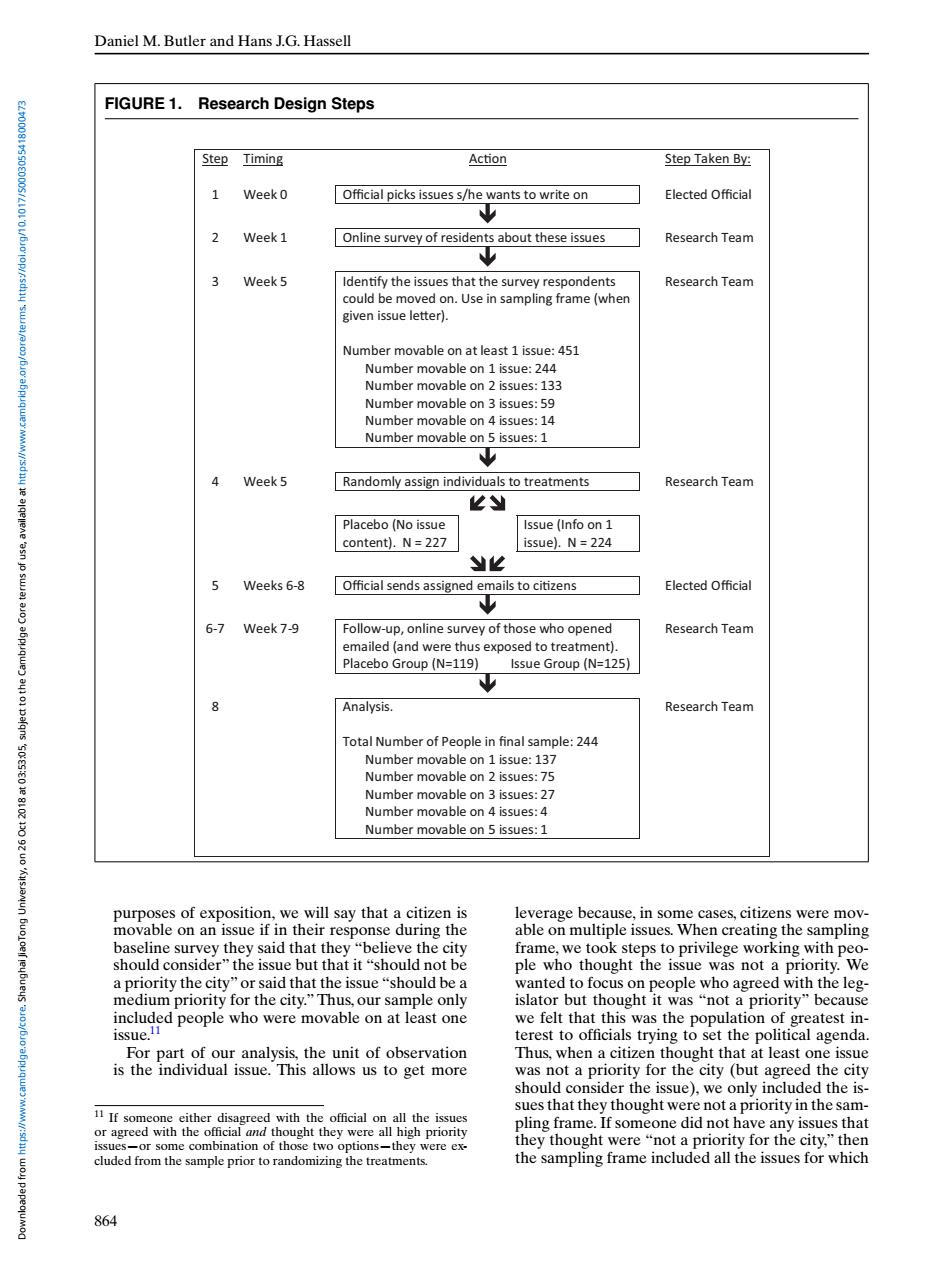正在加载图片...

Daniel M.Butler and Hans J.G.Hassell FIGURE 1.Research Design Steps Step Timing Action Step Taken By: 1 Week 0 Official picks issues s/he wants to write on Elected Official V 2 Week 1 Online survey of residents about these issues Research Team Y 3 Week 5 Identify the issues that the survey respondents Research Team could be moved on.Use in sampling frame (when given issue letter). Number movable on at least 1 issue:451 Number movable on 1 issue:244 Number movable on 2 issues:133 Number movable on 3 issues:59 Number movable on 4 issues:14 Number movable on 5 issues:1 V 4 Week5 Randomly assign individuals to treatments Research Team 化Y Placebo (No issue Issue (Info on 1 content).N=227 issue).N=224 丝 5 Weeks 6-8 Official sends assigned emails to citizens Elected Official V 6-7 Week 7-9 Follow-up,online survey of those who opened Research Team emailed (and were thus exposed to treatment). Placebo Group(N=119) Issue Group(N=125) Analysis. Research Team Total Number of People in final sample:244 Number movable on 1 issue:137 Number movable on 2 issues:75 Number movable on 3 issues:27 Number movable on 4 issues:4 Number movable on 5 issues:1 purposes of exposition,we will say that a citizen is leverage because,in some cases,citizens were mov- movable on an issue if in their response during the able on multiple issues.When creating the sampling baseline survey they said that they"believe the city frame,we took steps to privilege working with peo- should consider"the issue but that it"should not be ple who thought the issue was not a priority.We a priority the city"or said that the issue"should be a wanted to focus on people who agreed with the leg- medium priority for the city."Thus,our sample only islator but thought it was "not a priority"because included people who were movable on at least one we felt that this was the population of greatest in- issue.11 terest to officials trying to set the political agenda. For part of our analysis,the unit of observation Thus,when a citizen thought that at least one issue is the individual issue.This allows us to get more was not a priority for the city (but agreed the city should consider the issue),we only included the is- sues that they thought were not a priority in the sam- 11 If someone either disagreed with the official on all the issues pling frame.If someone did not have any issues that or agreed with the official and thought they were all high priority issues-or some combination of those two options-they were ex- they thought were "not a priority for the city,"then cluded from the sample prior to randomizing the treatments. the sampling frame included all the issues for which 864Daniel M. Butler and Hans J.G. Hassell FIGURE 1. Research Design Steps Step Timing Acon Step Taken By: 1 Week 0 Official picks issues s/he wants to write on Elected Official 2 Week 1 Online survey of residents about these issues Research Team 3 Week 5 Idenfy the issues that the survey respondents could be moved on. Use in sampling frame (when given issue leer). Number movable on at least 1 issue: 451 Number movable on 1 issue: 244 Number movable on 2 issues: 133 Number movable on 3 issues: 59 Number movable on 4 issues: 14 Number movable on 5 issues: 1 Research Team 4 Week 5 Randomly assign individuals to treatments Research Team Placebo (No issue content). N = 227 Issue (Info on 1 issue). N = 224 5 Weeks 6-8 Official sends assigned emails to cizens Elected Official 6-7 Week 7-9 Follow-up, online survey of those who opened emailed (and were thus exposed to treatment). Research Team Placebo Group (N=119) Issue Group (N=125) 8 Analysis. Total Number of People in final sample: 244 Number movable on 1 issue: 137 Number movable on 2 issues: 75 Number movable on 3 issues: 27 Number movable on 4 issues: 4 Number movable on 5 issues: 1 Research Team purposes of exposition, we will say that a citizen is movable on an issue if in their response during the baseline survey they said that they “believe the city should consider” the issue but that it “should not be a priority the city” or said that the issue “should be a medium priority for the city.” Thus, our sample only included people who were movable on at least one issue.11 For part of our analysis, the unit of observation is the individual issue. This allows us to get more 11 If someone either disagreed with the official on all the issues or agreed with the official and thought they were all high priority issues—or some combination of those two options—they were excluded from the sample prior to randomizing the treatments. leverage because, in some cases, citizens were movable on multiple issues. When creating the sampling frame, we took steps to privilege working with people who thought the issue was not a priority. We wanted to focus on people who agreed with the legislator but thought it was “not a priority” because we felt that this was the population of greatest interest to officials trying to set the political agenda. Thus, when a citizen thought that at least one issue was not a priority for the city (but agreed the city should consider the issue), we only included the issues that they thought were not a priority in the sampling frame. If someone did not have any issues that they thought were “not a priority for the city,” then the sampling frame included all the issues for which 864 Downloaded from https://www.cambridge.org/core. Shanghai JiaoTong University, on 26 Oct 2018 at 03:53:05, subject to the Cambridge Core terms of use, available at https://www.cambridge.org/core/terms. https://doi.org/10.1017/S0003055418000473���